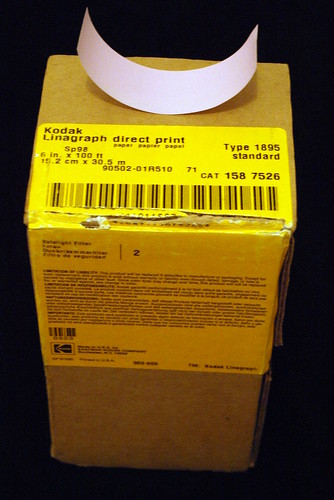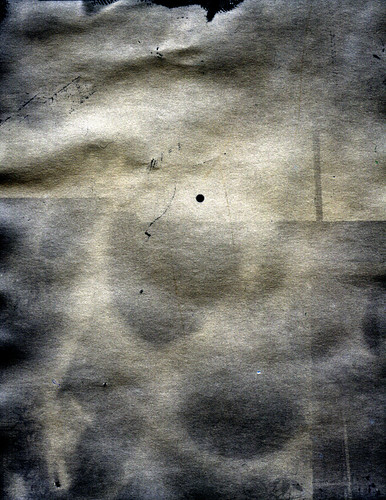I was experimenting with some stuff called Kodak Linagraph paper today. I really can't find much about it on the web, but it seems rather wacky...

Paper negatives
My favourite quick-and-cheerful method for testing new equipment, especially lenses, is to use paper instead of film in the camera. This can be done with any size camera - you need to cut photographic paper to size and perhaps tape it in place inside the camera. Of course this has to be done in the dark, but the advantage of paper is that everything can be done with an orange safelight, so there's no fiddling in the dark.
For large format cameras it's especially easy to load film holders with paper. You may need to be prepared to trim the paper slightly because (believe it or not) 4x5 film is smaller than 4x5 paper (that's the surprising bit) and film holders are designed for film not paper (that's less surprising).
Paper can be exposed like film. It is not sensitive to red light or to much green light much, but in daylight that's not much of a problem. Depending on the paper I expose mine at 2,3,4,6 ISO or higher in daylight. 3ISO is five stops slower than 100ISO. I take my light readings at 100ISO and calculate from there. There's a further advantage that exposures are typically a second or more, so shutters can be dispensed with in favour of the old manual method of using the lens cap as a shutter.
The other advantage is that it's easy to have trays of developer set up in the darkroom, so that (at least if you are shooting your tests in the back garden, which is what I do) each shot can be developed and inspected before the next is taken. Paper is also much cheaper than film.
For Ilford Multigrade paper, which is a little on the slow side but is one of the commonest kinds, I use ISO 3 as a starting point. Others are a bit faster.
After processing, the paper is washed and dried as usual and is scanned on a normal flat bed scanner. If your scanner is reasonable you should be able to get enough detail from even a 35mm negative. No special negative scanner is needed. Of course you will need to invert the tones - you might be able to do this in your scanning software, or any digital processing software will do this. (I use the Gimp.) Less obviously, the image you get will be a mirror image, so a "flip" transform (either left-right or top-bottom) may be helpful, but this is easy in software.
Linagraph direct print paper
I got a quantity of this stuff, which looked like it was worth a try. But it's not designed for normal printing. So on this occasion my paper-negative tests were testing the paper, not the lens. I chose a safe, dependable lens (which was in fact an enlarger lens, but quite good enough for the purpose), fitted it to the camera, loaded some of the paper into the holders and had a go.
A typical negative I got looked like this.

After letting the paper dry and then scanning it and processing it, this was the picture I got.

Pretty good really. There's a nice warm colour, due to my colour-inversion and the fact the paper is slightly cool. The paper appears to be sensitive to green, unlike normal papers, and is quite fast. (I exposed at 16ISO and developed slightly long at 2.5 minutes in PQ universal developer, 1+9.)
Conclusions
Other people may have found some of this paper, so perhaps my very early conclusions on it so far may be useful.
It is fast, at least one and perhaps two stops faster than normal paper. My sample gave a noticeable grey background, which is OK for negatives but not OK for prints. Next time I will try reducing the development time and increasing the exposure, hoping for better whites. Or a different developer might help.
The paper is very delicate when wet and scratches and other marks are very easy to make.
The instructions on the box say to use safelight filter 2, which is a red filter for fast orthochromatic films. Therefore a normal darkroom filter (which is what I used) may not be sufficiently safe. You should certainly experiment.
The pink colour of the emulsion is slightly offputting at first, but it does go when the paper is processed normally.
Solarisation
I thought it might be fun to try the paper in a completely different way, especially as I had no idea what it was specifically designed for.
The sun was bright so I pointed my camera towards it and set the shutter for a long exposure. (In fact, I used 2 seconds at f/11.) And shot.
My first attempt produced (unsurprisingly) a negative that was completely black. Rather than reducing the exposure I decided to reduce the development time, and to my delight, produced a negative in which the sun was perfectly white. After scanning, inverting colours and maximising the tones in the other areas (which are almost uniformly grey, but the scanner could find some slight differences) this is the image.

That's not a negative, but a positive. The sun is quite white on the negative. The other features (for example, a dark doorway to the bottom right) are dark/bright as expected for a positive - everything except the sun.
And it is not hi-fi my any means, and the scratches seem very easy to make on this paper, but this reversal of very bright objects is a lot of fun to do when the materials are right for it. The effect is known, and is usually called "solarisation", but isn't the same as the "Sabbatier effect" (also often called soloarisation, and perhaps something for a future post). Solarisation worked really well with this paper, and much better than conventional paper I tested it against. So this might be an interesting application. More experiments are obviously needed.
Interesting. I picked up some Linagraph on Ebay for $20 and occasionally play with it. I gather it was developed as a recording medium in the 1950's and 60's before digital recording. I think a high-energy beam makes a line on it and it doesn't need developing. There is meant to be a suite of Kodak publications on it but no one seems to have them. However you can process it like a normal paper. It must be done in darkness, not under a safelight and the image is quite fragile when wet (the image will just "float" off the paper. It gives a rather "different" appearance and can be moderately addictive when you get the exposure right and the image stays on the paper. Once dry it is stable. I certainly enjoyed playing with it. It is not very sensitive to red light.
ReplyDeleteI'd be interested in looking at any images (lbren@ncable.net.au).
Cheers
Leon Bren
Ps: I also discovered it takes to lith-printing rather nicely.
DeleteLeon
Hi Richard: I was wondering if you still had a roll (or more?) of the 1895 paper, and if so would you be willing to sell it? Or if you have access to more, let me know (if you can) where you found it. It's used in the laser industry for cheap and quick beam profiling. Let me know. Thanks, John
ReplyDeletehi J Black, I am also looking for it for the same reason. Its out of production and is very difficult to get. Please do let me know if you have any information about the availability of this.. pls drop a mail to snowleopardllc@gmail.com
DeleteHello, I am looking for the KODAK LINAGRAPH DIRECT PRINT PAPER 1895 for the laboratory needs. We align our laser using this paper. I will appreciate if there is anyone who can sell us the paper.
ReplyDeleteThank you in advance.
Regards
Diana
please contact me on dantonosyan@eosdefencesystems.com
ReplyDeleteI have some but it has been exposed to light. If you still want it let me know. Otherwise I'm throwing it away
ReplyDeleteDear Richard, Diana et al
ReplyDeleteIf there's anybody still looking at this . . way back in the 70s I used this stuff in Bell & Howell UV recorders - one could look at low-ish frequency signals including the 50~60 Hz mains voltage and monitor harmonics and all that good stuff. It was effectively a printing out paper, which would have continued to fog if one didn't apply a sprayed-on 'varnish'. I've still got one the galvanometers which 'waggled' the light beam to create the trace. Still going in the 80s was a British firm, Hathaway, who had a much more engineered box of tricks purely for mains frequency monitoring, with a magnetic drum recording the signals, which after a transient was identified allowed the data to output to the Linagraph paper. And all done without a computer!
Dear Diana: why don't you just use cartridge paper and burn an image for your alignment checks. I am also a printmaker who uses a laser to cut and engrave woodblocks and other stuff.
Regards
Roger Farnham, Glasgow